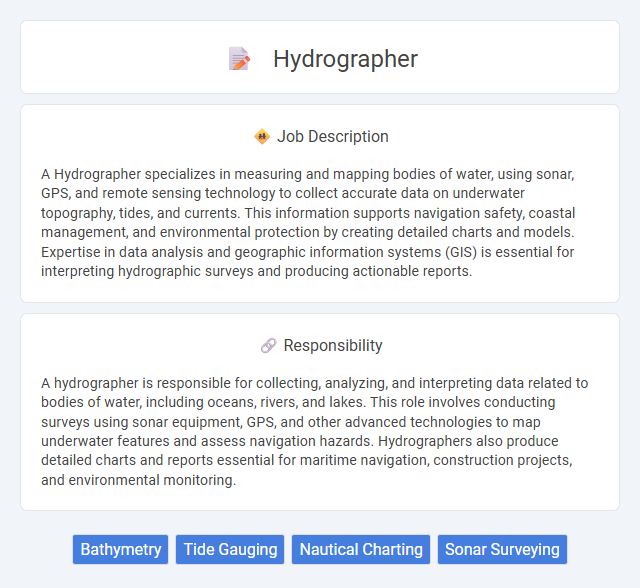
A Hydrographer specializes in measuring and mapping bodies of water, using sonar, GPS, and remote sensing technology to collect accurate data on underwater topography, tides, and currents. This information supports navigation safety, coastal management, and environmental protection by creating detailed charts and models. Expertise in data analysis and geographic information systems (GIS) is essential for interpreting hydrographic surveys and producing actionable reports.
People who enjoy working outdoors and studying water bodies may find a career as a hydrographer suitable, as the job often involves fieldwork in varying weather conditions. Those with strong analytical skills and an interest in geography or environmental science might be more likely to excel in tasks such as mapping and data analysis. However, individuals preferring routine indoor work or lacking physical stamina could find the demands of hydrographic surveys challenging.
Qualification
A Hydrographer must possess a bachelor's degree in geoscience, marine science, or a related field, with specialized training in hydrographic surveying and data analysis. Proficiency in using sonar systems, GPS technology, and geographic information systems (GIS) is essential for accurate maritime mapping and data collection. Certification from recognized bodies such as the International Hydrographic Organization (IHO) enhances credibility and career advancement opportunities.
Responsibility
A hydrographer is responsible for collecting, analyzing, and interpreting data related to bodies of water, including oceans, rivers, and lakes. This role involves conducting surveys using sonar equipment, GPS, and other advanced technologies to map underwater features and assess navigation hazards. Hydrographers also produce detailed charts and reports essential for maritime navigation, construction projects, and environmental monitoring.
Benefit
A career as a hydrographer likely offers the benefit of contributing to maritime safety and environmental conservation through the precise mapping of water bodies. It is probable that hydrographers experience opportunities for extensive fieldwork combined with technological innovation, enhancing their professional skills. The role may also provide job stability and growth potential given the increasing demand for accurate aquatic data in various industries.
Challenge
Hydrographers likely face the challenge of accurately mapping and analyzing underwater terrains in diverse and often unpredictable conditions. The probability of encountering technical difficulties with advanced surveying equipment could impact data precision. Managing environmental factors such as weather and water currents may further complicate data collection and interpretation tasks.
Career Advancement
Hydrographers gain expertise in charting water bodies and analyzing aquatic environments, which positions them for advancement into senior technical roles or project management within maritime and environmental sectors. Mastery of geospatial technologies, data analysis software, and regulatory compliance enhances opportunities for leadership in hydrographic surveying, oceanographic research, and coastal resource management. Pursuing certifications such as the Certified Hydrographer or advanced degrees in marine science significantly boosts career prospects and salary potential.
Key Terms
Bathymetry
Hydrographers specializing in bathymetry map underwater topography by measuring water depths using sonar, LiDAR, and satellite technology to create detailed seabed charts. These professionals analyze data to support marine navigation, coastal development, and environmental research, ensuring safe shipping routes and habitat preservation. Expertise in GIS software and data processing is essential to accurately interpret bathymetric surveys and generate 3D models of underwater landscapes.
Tide Gauging
Hydrographers specializing in tide gauging collect and analyze sea level data to monitor tidal patterns and their impact on coastal environments. Using precise tide gauges and sensors, they measure fluctuations in water levels crucial for navigation, flood forecasting, and coastal infrastructure planning. Their work supports maritime safety, climate research, and sustainable development in coastal zones.
Nautical Charting
Hydrographers specializing in nautical charting collect and analyze underwater topography data to create accurate maritime maps essential for safe navigation. They utilize advanced sonar, GPS, and GIS technologies to survey ocean floors, identify hazards, and update nautical charts for commercial shipping and naval operations. Precise hydrographic surveys ensure compliance with international maritime standards and support maritime infrastructure development.
Sonar Surveying
Hydrographers specializing in sonar surveying use advanced sonar technology to map underwater terrain, accurately detecting seabed features, obstructions, and depth variations essential for safe navigation and construction projects. They analyze and interpret sonar data to create detailed bathymetric maps and charts, supporting maritime infrastructure, environmental monitoring, and naval operations. Expertise in multibeam and side-scan sonar systems enables hydrographers to deliver precise underwater surveys critical for dredging, cable laying, and offshore resource exploration.
 kuljobs.com
kuljobs.com